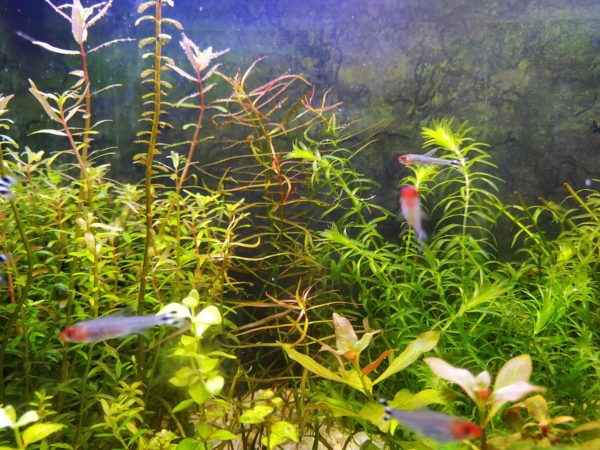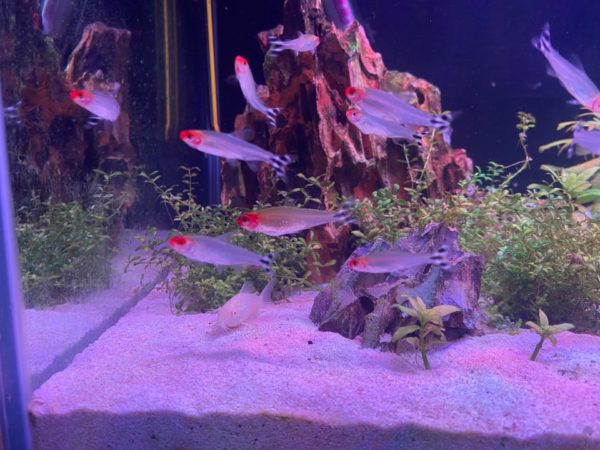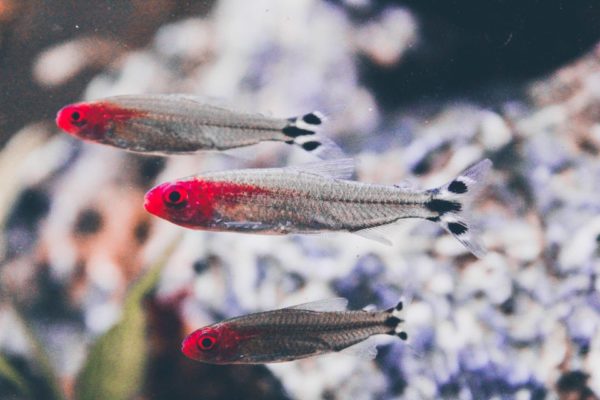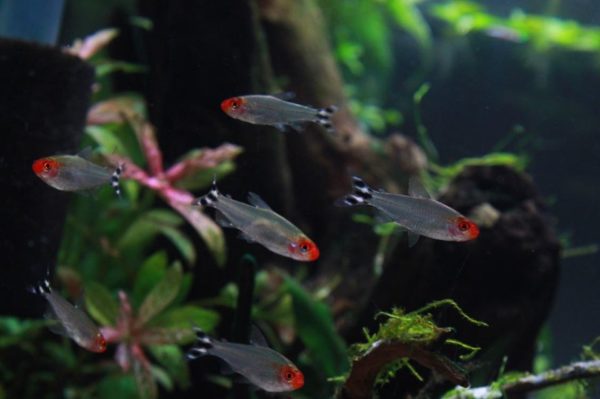Table of Contents
Rummy Nose Tetra: A Quick Summary
Rummy nose tetras are small, colorful fish native to South America, popular in freshwater aquariums for their peaceful temperament and attractive appearance. They have red, rummy-shaped noses and silver bodies with black stripes.
Rummy Nose Tetra Overview
Rummy nose tetra is a tropical freshwater fish and is native to South American rivers. Discovered by Heiko Bleher, the scientific name for this fish is Hemigrammus bleheri. They belong to the family Characids consisting of freshwater subtropical and tropical fishes
One of the many tetras in the genus, these fish are a favorite among the others for fishkeeping. They are nicknamed firehead tetra or firetip tetra. They are easy to take care of and their unique colors make them an attractive addition to the fish tank.
| Information chart | Rummy nose tetra |
| Scientific name: | Hemigrammus Bleheri |
| Family: | Characidae |
| Care level: | Moderate |
| Temperament: | Peaceful |
| Color: | Silver, red, black, and white |
| Lifespan: | 5-6 years |
| Size: | 2-2.5 inches |
| Diet: | Omnivorous |
| Minimum tank size: | 20 gallon |
| Temperature: | 75°F – 84°F |
| Water conditions: | pH 5.5 – 7.0 |
| Tank mate compatibility: | Other tetra species and catfish |
Rummy Nose Tetra Appearance

The Rummy Nose Tetras are unique fish because of their notably bright colors and patterns across their body. At first glance, they may look like a combination of different fishes put together although that is not the case. It is because their bodies consist of various colors and markings.
These fishes have a slender profile with a torpedo-shaped body and bigger heads. Their bodies have a base color of silver, accompanied by a semi-translucent tinge of green. Most of their fins are translucent and small with the tail fin being an exception. The tail fin (caudal fin) has black and white horizontal stripes that resemble the zebra pattern. There is a single central black stripe that separates the two sides of the fin. The number of stripes on the fin differs in each fish. But this common trait gives them a noticeable difference in color compared to the rest of the body.
It does not stop there though. The Rummy Nose Tetras’ most distinguishing features remain their bright red heads, giving them the nickname of firehead tetras. Their striking color covers the entire head and extends into their irises. The bright red color is an indicator of their good health and water quality. If the bright red color turns pale at any point, it is a sign that the fish is going through a stressful time.
Types and varieties of Rummy Nose Tetras
There are three species of fish classified as rummy nose tetras. Hemigrammus rhodostomus is the primary species known to be the true Rummy Nose Tetra. While the Hemigrammus bleheri is known as the common rummy nose tetra, the Petitella georgiae is known as the false Rummy Nose Tetra. They all look so similar that it’s hard for the breeder themselves to set them apart. But, there are minor differences between the three species in their size and variations in the color of their fins and heads.
The lifespan of the Rummy Nose Tetra
The typical lifespan of a Rummy Nose Tetra is five to six years.
But there are exceptional cases where the fishes live up to eight years. Genetics, water conditions, and diet all play a major role in the lifespan of a fish. While all these factors are necessary for their full development, they need ample care and the right environment to aid them to grow to the fullest.
Size of the Rummy Nose Tetra
The typical rummy nose tetra typically grows up to 2 inches on the lower end and 2.5 inches for larger specimens. They are small fish, ideal for small tanks, and do not grow much larger.
Natural habitat and origin
These species are native to South America and hail from different parts of the Amazon river. The true Rummy Nose Tetra inhabits the lower Amazon basin in the Para state and Orinoco river while the firehead tetra inhabits the Rio Negro and Rio Meta basins. The false tetra inhabits the upper Amazon basin in Peru and Brazil and is more inland. All three species inhabit water bodies that are soft and acidic. The acidic base of the river is due to the decayed plant leaves and other organic matter. They prefer inhabiting the middle and mid-lower water regions where aquatic flora and fauna are less.
Rummy Nose Tetra care and tank setup

Rummy nose tetra Tank Size and Specifications
Since these fish are small in size and gentle in nature, they do not need huge tanks to keep them in place. However, they are schooling fish and are swimmers so very small tanks cannot hold them. An ideal size to keep these fish comfortably would be a tank that can hold up 20-25 gallons of water or an 80-liter aquarium. The ideal requirement for each fish would be around 2 gallons and hence a 20- gallon tank is sufficient to raise 10 of these fishes.
Water parameters for Rummy Nose Tetra
These fishes like warm water therefore the temperature should be at 75 – 84 degrees Fahrenheit. The pH of the water can range from 5.5 to 7.0 since these fish prefer their water conditions to be acidic and soft. To maintain a stable environment and the health of the fish, the hardness of the water should be 2-6 KH.
Rummy nose tetras are sensitive fishes so any changes in the water condition can lead to problems in their health. Excess waste and not cleaning the algae buildup can create stress in the fish hence it is important to check the water levels and change the water regularly.
Rummy Nose Tetras Tank landscape
Keeping the natural habitat setting in mind, setting up the tank for these fishes is relatively easy and flexible. The Tetras are used to sandy and rocky beds in their native habitats so using sand, rocks, logs, driftwoods would be ideal. Rough bases for the bottom of the tank such as gravel or rocks can also be used since the fish are not diggers. Decorations and lighting provide the fish with shelter and sunlight that they are used to in their native habitats. Standard aquarium lighting works best for them. However, make sure to not overcrowd the tank with decorations as these fish need a lot of space to swim freely. Leaving open space in the middle section of the tank would be best for their swimming and feeding activities.

These fishes are peaceful creatures who do not attack or harm the decorations in the tank so keeping plants that grow till the middle section of the tank would be the best. Since plants also provide shelter to the fishes when they feel uneasy, they are a great addition to the tank. It is also fine to add plants with fewer leaves as the fishes do not eat more of them. Suitable plant options would include the Anubias nana, amazon sword, and water wisterias, etc. You can also use fine-leaved aquatic plants like Cabomba and parrot-feathers.
Rummy Nose Tetra Feeding
The best diet for Rummy Nose Tetra
Rummy Nose Tetra are omnivores, meaning they eat anything as long it fits their mouth. They are not picky eaters and consume a variety of foods ranging from proteins to plants. Other than plant material, live bloodworms and daphnias are a personal favorite for these fish. Feeding them flake and food pellets would be ideal as they are rich in all the nutrients needed for the fish to grow. They can also be given grated or chopped vegetables in small quantities so they do not eat the leaves of the aquatic plants.
Their diet can also include live foods as a treat as they are a good source of protein that the fish need. Their color development also depends on the diet they eat so make sure to provide all the required nutrients and check daily consumption. Unlike other fish species that feed at the surface and like eating mosquitoes, the Rummy Nose Tetra is not very fond of mosquito larvae. They also prefer eating their meals in the middle or lower sections of the aquarium.
How often should you feed the Rummy Nose Tetra?
Feeding the fish two to three times a day should be more than enough. You have to make sure the fishes finish the food in under three to four minutes. The fishes have to be fed small meal potions so it’s easier for them to digest all the food. Be careful not to give excess food as this can take a toll on their health and create decay in the tank.
Rummy Nose Tetra Behavior and Temperament
Are Rummy Nose Tetras lone or societal?

Rummy Nose Tetras are gentle and passive fishes that can coexist peacefully with other fish, especially other tetra species. They travel in groups and it is preferred to keep at least six of them together while raising these fishes. Since they are used to living with shoals of fishes, keeping them separate may cause them stress and make them an easier target as prey. The only time they separate would be while getting food or while sheltering themselves. Hence, they are very social.
Rummy Nose Tetra tank mates
Ideal Tank Mates for the Rummy Nose Tetra
Since these fishes are very peaceful and don’t show violent tendencies, the perfect tank mates would be other peace-loving fishes who are bottom dwellers. Compatible tank mates include Angelfish, Harlequin rasbora, neon tetra, betta fish, Gold Tetra, discus fish, American Flagfish or the corydoras catfish. Shrimp and snails can also be put in the same tank as these tetras.
Bad tank mates for the Rummy Nose Tetra
The bright red color of the rummy nose tetras head makes them an easy target for larger, aggressive fishes. Hence fishes that are carnivores and view other fishes as food should be avoided in the same tank.
Rummy Nose Tetra Breeding
Rummy Nose Tetras are not difficult to breed. However, they do require special attention and specific conditions to spawn. The main issue in breeding these fishes is pairing the sexes as it is rather difficult to find out the sexes of the fish. The only option is trial and error wherein you keep many of them together and select the ones that pair. The slow growth of the fry and their survival rates are also an obstacle but with optimum conditions and extra care, this process can be smooth.

Rummy nose tetras are oviparous animals that scatter their eggs. Hence you should raise the temperature of the water to 84 degrees Fahrenheit. The water should be very clean as these fishes are sensitive and cannot breed in polluted water. Before breeding, the females and the males should be separated and kept in softer water which is 1-2 degrees warmer, with a pH level of 6.6-6.8. It is recommended to use a mixture of rain, distilled, and forest puddle water with a decoction of peat for the spawning water.
The female initiates by swimming over to a leaf and turning over for the male to fertilize the eggs. She will then lay the eggs onto a large leaf, which after 24 hours will hatch. At this point, it is best to remove the male fishes as they may feed on the eggs. After hatching, the fry survives off the egg sac for a few days and then swims around. Providing the fry with specialized powder solutions as food is necessary for their growth after which you can introduce them to the community of the rummy nose tetras.
Rummy Nose Tetra Breeding level
Intermediate
Rummy Nose Tetra Sexual Dimorphism
To distinguish between male and female Rummy Nose Tetra we look at their body types. While the males have a more slender body and have a characteristic hook on the rear fin, the females have a rounded abdomen and are smaller in size.
Rummy Nose Tetra Common Disease and their Treatment
Irch Disease
Rummy Nose Tetras can suffer from common diseases that could be due to various reasons. Irch is a parasitic infection that manifests itself in white spots all over the body. It is a contagious disease so it is important to quarantine the fish. The use of simple medications is enough for the cure.
Dropsy
Dropsy is an accumulation of fluids inside the body that cause the fish to swell up, making them look different from their usual appearance. Several reasons can be the cause but the primary cause would be a bacterial infection. The treatment is curable with available medicines.
These diseases are preventable by taking some early precautions. Changing the water at regular intervals, maintaining the water level, introducing healthy fish only, etc are some things to keep in mind.
Are Rummy Nose Tetras right for you?
These fishes are unique, gentle and a real pleasure to look at. It is rather easy to take care of them, although they do require quite a bit of work if you plan to breed them. With a little bit of effort on your part in maintaining them, they can add that life to your fish tank with their attractive bright colors.

FAQs
Do Rummy Nose Tetras lose color?
Yes, they can lose color when they get stressed. It can be due to changes in the water level or diet or if they are in danger.
Are Rummy Nose Tetras fin nippers?
They are passive fish who remain calm most of the time. Yet, they may become fin nippers if they feel the need to fend for themselves, especially if kept with aggressive fish. It can also happen when they get stressed.
Can Rummy Nose Tetras live with Neon Tetras?
Rummy nose tetras and neon tetras are both gentle species so they can coexist.
How many rummy nose tetras can I put in a 10-gallon tank?
Each fish needs two gallons so you can put five Rummy nose tetras in a 10-gallon tank.
If my Rummy Nose Tetra lays eggs, where will they lay them?
The females lay their eggs on large leaves of plants. So it would be beneficial to have aquatic plants in your tank if you plan to breed them.
Conclusion
Raising Rummy Nose Tetras can be very fun, especially if you are looking for something different from the usual fish one can see in every home. With a bit of maintenance and attention, they can be the new exciting addition you have never had before.
No related posts.
